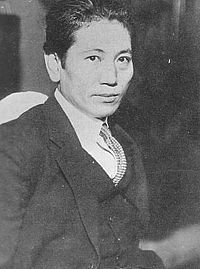- Musei Tokugawa
-
Musei Tokugawa (徳川 夢声 Tokugawa Musei, 13 April 1894 – 1 August 1971) was a Japanese benshi, actor, raconteur, essayist, and radio and television personality. Musei (as he was called) first came to prominence as a benshi, a narrator of films during the silent era in Japan. He was celebrated for his restrained but erudite narration that was popular among intellectual film fans.[1] He concentrated on foreign films such as The Cabinet of Dr. Caligari at high-class theaters like the Aoikan and the Musashinokan, but also performed Japanese works such as Teinosuke Kinugasa's experimental masterpiece A Page of Madness (1926).[2] As the silent era ended, Musei switched to storytelling on stage and on radio, and also began acting and doing narrations in films. He was also famous for his essays, humorous novels, and autobiographical writings,[1] publishing nearly fifty books in his life.[3] With the advent of television in Japan, Tokugawa also became a prominent presence in that medium.
Notes
- ^ a b Dym, Jeffrey A. "Tokugawa Musei: A Portrait Sketch of One of Japan's Greatest Narrative Artists." In Praise of Film Studies: Essays in Honor of Makino Mamoru. Eds. Aaron Gerow and Abé Mark Nornes (Kinema Club, 2001).
- ^ Gerow, Aaron (2008). A Page of Madness: Cinema and Modernity in 1920s Japan. Center for Japanese Studies, University of Michigan. pp. 53. ISBN 9781929280513..
- ^ Tokugawa Musei chosho, Japanese Wikipedia
External links
- Musei Tokugawa at the Internet Movie Database
- Tokugawa Musei at the Japanese Movie Database (Japanese)
- Clip of one of Musei Tokugawa's benshi performances.
- Find-A-Grave profile for Musei Tokugawa
Categories:- 1894 births
- 1971 deaths
- Japanese actors
- Japanese radio personalities
- Japanese essayists
- Benshi
Wikimedia Foundation. 2010.

